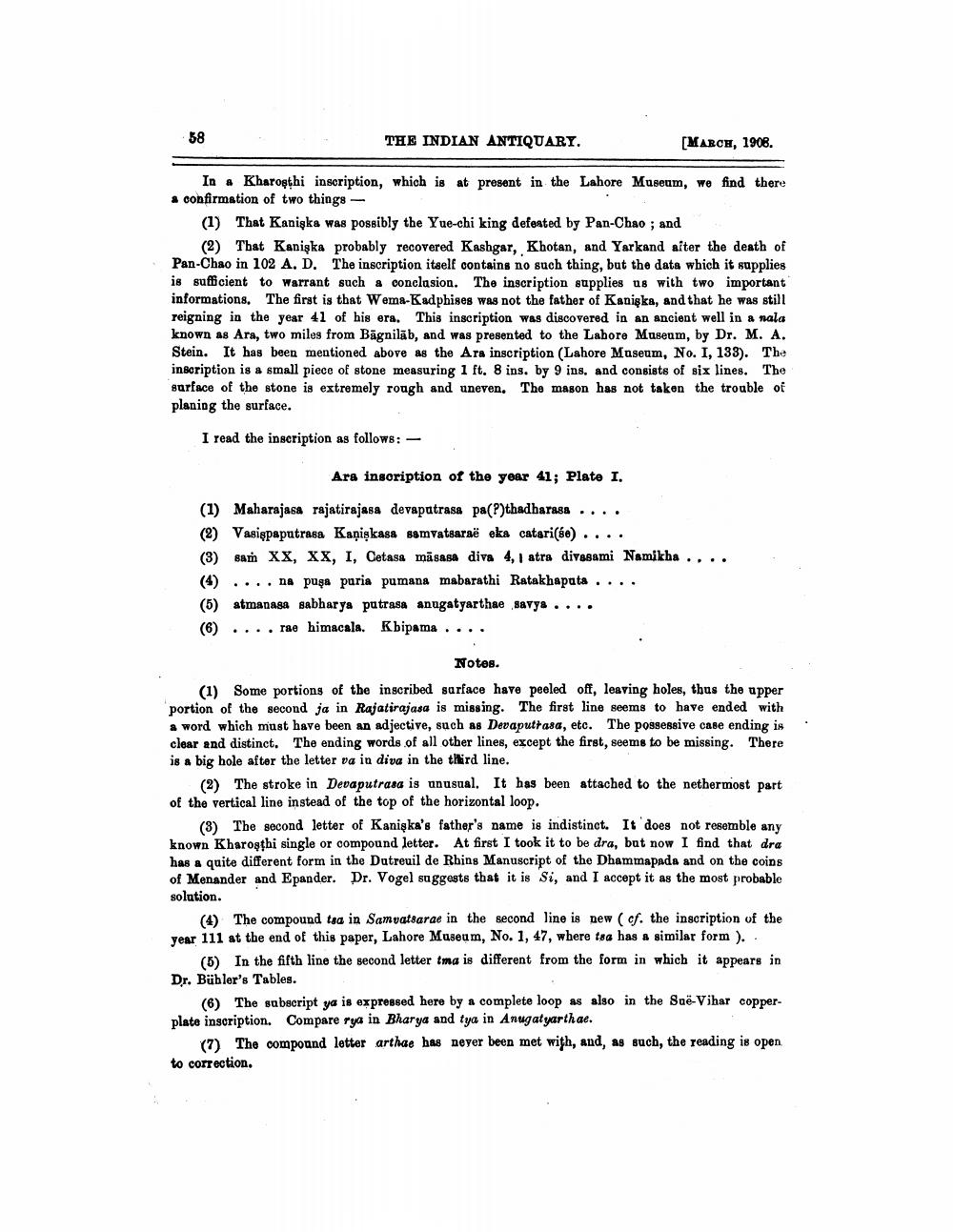________________
38
THE INDIAN ANTIQUARY.
[MARCH, 1908.
-
In & Kharoşthi inscription, which is at present in the Lahore Museum, we find there confirmation of two things -
(1) That Kaniska was possibly the Yue-chi king defeated by Pan-Chao ; and
(2) Tbat Kaniska probably recovered Kashgar, Khotan, and Yarkand after the death of Pan-Chao in 102 A. D. The inscription itself contains no such thing, but the data which it supplies is sufficient to warrant such a conclusion. The inscription supplies us with two important informations. The first is that Wema-Kadphises was not the father of Kanigka, and that he was still reigning in the year 41 of his era. This inscription was discovered in an ancient well in a nala known as Ara, two miles from Bāgnilāb, and was presented to the Labore Museum, by Dr. M. A. Stein. It has been mentioned above as the Ara inscription (Lahore Museum, No. I, 133). The inscription is a small piece of stone measuring 1 ft. 8 ins. by 9 ins, and consists of six lines. The surface of the stone is extremely rough and uneven. The mason has not taken the trouble of planing the surface.
I read the inscription as follows:
Ara insoription of the year 41; Plate I.
(1) Maharajasa rajatirajasa devapatrasa pa(?)thadbarasa ..... (2) Vasigpaputrasa Kaņiskasa samvatsaraë eka catari(60) .... (3) saṁ XX, XX, I, Cetasa māsasa diva 4, 1 atra divasami Namikha .... (6) .... na puga paria pumana mabarathi Ratakhapata .. (5) atmanasa sabharya putrasa anugatyarthae savya .... (6) .... rae himacala. Kbipama ....
Notes. (1) Some portions of the inscribed surface have peeled off, leaving holes, thus the upper portion of the second ja in Rajatirajasa is missing. The first line seems to have ended with a word which must have been an adjective, such as Devaputt asa, etc. The possessive case ending is clear and distinct. The ending words of all other lines, except the first, seems to be missing. There is a big hole after the letter va in diva in the third line.
(2) The stroke in Devaputrasa is unusual. It has been attached to the nethermost part of the vertical line instead of the top of the horizontal loop.
(3) The second letter of Kaniska's father's name is indistinct. It does not resemble any known Kharoşthi single or compound letter. At first I took it to be dra, but now I find that dra has a quite different form in the Datreuil de Rbins Manuscript of the Dhammapada and on the coins of Menander and Epander. Dr. Vogel suggests that it is Si, and I accept it as the most probable solution.
(4) The compound tna in Samvatsarae in the second line is new (cf. the inscription of the year 111 at the end of this paper, Lahore Museum, No. 1, 47, where tsa has a similar form )..
(5) In the fifth line the second letter ima is different from the form in which it appears in Dr. Bübler's Tables.
(6) The subscript ya is expressed here by a complete loop as also in the Sue-Vihar copperplate inscription. Compare rya in Bharya and tya in Anugatyarthae.
(7) The compound letter arthae has never been met with, and, as such, the reading is open to correction.




